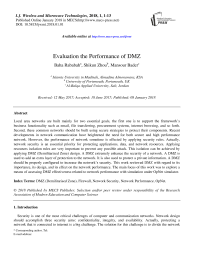Evaluation the performance of DMZ
Автор: Baha Rababah, Shikun Zhou, Mansour Bader
Журнал: International Journal of Wireless and Microwave Technologies @ijwmt
Статья в выпуске: 1 Vol.8, 2018 года.
Бесплатный доступ
Local area networks are built mainly for two essential goals, the first one is to support the framework’s business functionality such as email, file transferring, procurement systems, internet browsing, and so forth. Second, these common networks should be built using secure strategies to protect their components. Recent developments in network communication have heightened the need for both secure and high performance network. However, the performance of network sometime is effected by applying security rules. Actually, network security is an essential priority for protecting applications, data, and network resources. Applying resources isolation rules are very important to prevent any possible attack. This isolation can be achieved by applying DMZ (Demilitarized Zone) design. A DMZ extremely enhance the security of a network. A DMZ is used to add an extra layer of protection to the network. It is also used to protect a private information. A DMZ should be properly configured to increase the network’s security. This work reviewed DMZ with regard to its importance, its design, and its effect on the network performance. The main focus of this work was to explore a means of assessing DMZ effectiveness related to network performance with simulation under OpNet simulator.
DMZ (Demilitarised Zone), Firewall, Network Security, Network Performance, OpNet
Короткий адрес: https://sciup.org/15016913
IDR: 15016913 | DOI: 10.5815/ijwmt.2018.01.01
Список литературы Evaluation the performance of DMZ
- T. B. D. L. E. Q. J. P. D. M. Z. N. O. Christian Barnes, Hackproofing Your Wireless Network, USA: Syngress, 2002.
- S. Young, “Designing a DMZ,” SANS Institute InfoSec Reading Room.
- E. Dart, L. Rotman, B. Tierney and J. Z. Mary Hester, “The Science DMZ: A Network Design Pattern for Data-Intensive Science”.
- E.-S. N. A. Sabry NASSAR, Improve the Network Performance By using Parallel Firewalls.
- J. M. ,. A. I. a. A. N. Q. Thaier Hayajneh, “Performance and Information Security Evaluation with Firewalls,” International Journal of Security and Its Applications, 2013.
- O. G. H. Garantla, “Evaluation of Firewall Effects on Network Performance”.
- S. E. John R. Vacca, Firewalls: Jumpstart for Network and Systems Administrators, MA, USA: Elsevier Digital Press, 2005.
- Sequeira, CCNA Security 640-554 Quick Reference, Cisco Press, 2012.
- E. Romanofski, “A Comparison of Packet Filtering Vs Application Level Fire wall,” Global Information Assurance Certification Paper.
- &. Y. H. S. S. Sethi, The practical OPNET User Guide for Computer Network Simulation, 2012.
- “OPNET Simulator,” [Online]. Available: http://users.salleurl.edu/~zaballos/opnet_interna/pdf/OPNET%20Simulator.pdf. [Accessed 24 06 2017].
- G. A. Donahue, Network Warrior, O’Reilly Media, Inc., 1005 Gravenstein Highway North, Sebastopol, CA 95472., 2007.
- M. Bishop, Computer Security: Art and Science, Addison Wesley, 2002.
- W. Stallings, CRYPTOGRAPHY AND NETWORK SECURITY PRINCIPLES AND PRACTICE, 5 ed., Pearson Education, 2011.
- J. Webb, Network Demilitarized Zone (DMZ).
- S. E. John R.Vacca, Firewalls Jumpstart for Network and Systems Administrators.
- M. K. E Aboelela, Network Simulation Experiments Manual.
- R. . J. Shimonski, W. Schmied, T. W. Shinder, V. Chang, D. Simonis and D. Imperatore, Building DMZ Enterprise Network, Syngress Publishing, 2003.
- F. F. R. A. M. M. S. Marco Antonio Torrez Rojas, “Science DMZ: Support for e-science in Brazil,” 2016.
- K. E. a. R. B. K. Salah, “Performance modeling and analysis of network,” IEEE, 2012.


